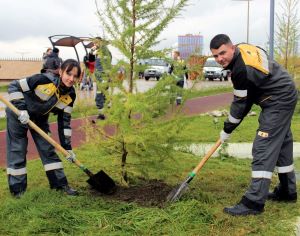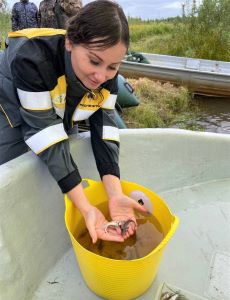Please activate JavaScript in your browser to use all interface options.
Samotlorneftegaz’s Green Investments Exceed 15 Billion Roubles in the First Nine Months of 2025
06 November 2025
In the first nine months of 2025, Samotlorneftegaz, one of Rosneft’s key production assets, allocated over 15 billion roubles to environment-oriented programmes and initiatives.
The enterprise implements a number of environmental programmes, including methane emission monitoring, land reclamation, safe disposal of industrial waste, restocking of Siberian rivers with fish, and reforestation.
Samotlorneftegaz has been implementing an investment programme for a number of years that includes the phased modernisation of gas infrastructure, with the aim of maintaining utilisation of associated petroleum gas at a rate of no less than 98%. The Samotlor field has an advanced and extensive system for collecting, preparing, compressing and transporting gas. The bulk of the feedstock goes to gas processing plants and local consumers.
Samotlorneftegaz monitors greenhouse gas emissions at the enterprise’s production facilities. Since the beginning of the year, over 2,600 measurements have been taken at oil and gas processing facilities using modern equipment such as infrared cameras, laser scanners and ultrasonic detectors. A further 230 measurements have been taken at mechanised well facilities. Surveys were conducted on gas pipelines with a total length of around 506 kilometres using unmanned aerial vehicles equipped with laser gas analysers.
As part of the pipeline reliability improvement programme, 152 km of oil field pipelines have been constructed since the beginning of the year. To ensure the durability of the pipeline system, the inner surfaces of the pipes are coated with modern domestic materials, and new technologies are used to process the welded joints. The existing pipeline network is being protected against corrosion using inhibitors.
Samotlorneftegaz has completed the «historic heritage» land reclamation project. The technical and biological stages of reclamation were carried out year-round due to the extensive use of proprietary winter reclamation and phytomelioration technologies. Samotlorneftegaz conducted most of its works using its own ecoservice, with unique specialised equipment for working in boggy areas.
 Another of the enterprise’s key tasks is maintaining ecological balance in its operating area by replenishing biological resources. Around 5,000 Siberian sterlet fry and over 750,000 muksun and nelma fry were released into the Ob-Irtysh basin. In recent years, the campaigns carried out in the northern rivers have led to the release of over 20 million fry of valuable fish species.
Another of the enterprise’s key tasks is maintaining ecological balance in its operating area by replenishing biological resources. Around 5,000 Siberian sterlet fry and over 750,000 muksun and nelma fry were released into the Ob-Irtysh basin. In recent years, the campaigns carried out in the northern rivers have led to the release of over 20 million fry of valuable fish species.
Over the last 10 years, the enterprise has planted more than 1.8 million conifers on Ugra forestry land, covering an area of 520 hectares. In addition to the forest areas, volunteers from the enterprise also planted trees in Nizhnevartovsk’s parks in 2025.
Preserving the environment for future generations is one of the key areas of Rosneft’s development strategy. The Company and its subsidiaries are implementing a number of comprehensive programmes to preserve biodiversity and conserve natural resources in the regions of operations. They are also striving to ensure environmentally friendly production processes and minimise their environmental impact.
For reference:
Samotlorneftegaz is one of Rosneft’s key production enterprises developing Russia’s largest Samotlor field located in the Khanty-Mansi Autonomous District - Yugra. The scope of license areas exceeds 2,900 square kilometres.
Department of Information and Advertising
Rosneft
November 6, 2025

-315xx70.png)

